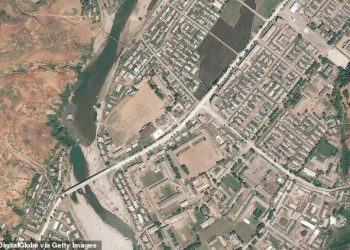China launched a spaceship to the lunar surface on Monday to become the first nation to bring back lunar rock and soil samples in more than four decades.
The Chang’e-5 mission is the latest step in an ambitious space program that China hopes will culminate in an international lunar research station and eventually a human colony on the moon by 2030.
The launch from the Wenchang space site on Hainan Island in southern China was broadcast live by Chinese state media. China has often kept its space missions secret and waited until it went into orbit before officially announcing success. The immediate broadcast can be a sign of growing confidence in the proven track record of its space program.
Cameras mounted on the rocket showed that the boosters were falling off and the protection over the robotic probe was ejected on its way into space. Audio and video from the mission’s control room recorded the Chinese space program staff, who applauded when the rocket’s first and second stages separated, and then when the spacecraft reached orbit about 15 minutes after launch. An additional ignition of the spacecraft’s engine set it on course for the moon.
If Chang’e-5’s journey to the moon and back is successful, China will only be the third nation to bring pieces of the moon back to earth. NASA astronauts accomplished this feat during the Apollo moon landings, as did the Soviet Union’s Luna robotic landers, which ended with Luna 24 in 1976. These samples have been instrumental in understanding the evolution of the solar system, and planetary scientists have been eagerly awaiting the day more samples would be returned to Earth.
“This is a really bold mission,” said David S. Draper, NASA’s assistant chief scientist. “You will move the ball across the field in a great way to understand many things that are important to lunar history.”
In recent decades, interest in returning to the moon has resurrected after the discovery of frozen water in shady craters in the polar regions. NASA has set itself the goal of sending astronauts on new moon landings with its Artemis program in the coming years. Commercial companies – some under contract with NASA – want to send robotic landers to the moon in the next year or two. India and an Israeli nonprofit attempted to land spaceships on the moon in 2019, but both spaceships crashed.
In this century, only China has successfully brought robotic spaceships to the lunar surface: Chang’e-3 in December 2013 and Chang’e-4, which was the first spaceship to land on the other side of the moon in January 2019. Chang’e-4’s rover, called Yutu-2, is still in service and studying lunar geology almost two years later.
Although China ventured into space much later than the United States and the Soviet Union, the country did tremendous progress in the past decade and is now one of the elite ranks of space nations. In addition to the moon missions, China’s astronauts have docked three times with space stations of their own structure in orbit. The Tianwen-1 mission set course for Mars in July and will attempt to land on the surface of the red planet next year.
These achievements have become a source of national pride that has been carefully managed to emphasize the strong and steady leadership of the Communist Party. China’s space program remains secret, but officials have offered more details than usual about Chang’e-5.
The entire Chang’e-5 mission, from launching to extracting the rock samples, will be completed in less than a month.
After the spaceship enters orbit around the moon, Chang’e-5 splits into two parts: one lander will go to the surface while the other part, an orbiter, awaits its return.
Once the lander hits the surface, in about a week it must complete all drilling and shoveling tasks on a single lunar day, which lasts 14 Earth days. The lander is not designed to survive the cold, dark moonlit night.
The Chang’e-5 lander contains a small missile that is fired before sunset with the rock and soil samples. This rocket will meet and dock with the piece of spacecraft that is in orbit. The samples will be handed over to the orbiter for the return journey to Earth.
The sample is scheduled to land in the Inner Mongolia region of China in mid-December.
In an interview with China’s state television broadcaster, Yu Dengyun, deputy chief designer of the Chinese lunar exploration project, admitted that the complex choreography of Chang’e-5 was more technically demanding than the previous missions.
“We’re launching rockets with relatively sophisticated technology on the ground, but we’re using the lander as a launch platform on the lunar surface,” he said. “We have never done before how we can dissipate heat, redirect currents and control the rise process. These are tough nuts that can be cracked. “
Chang’e-5 aims to bring more than four pounds of specimens back to Earth. In the 1970s, three successful Soviet Luna missions returned a total of about 10 ounces of the moon. NASA’s Apollo astronauts hauled back 842 pounds of lunar rock and earth. Scientists are still studying the Apollo and Luna samples.
The landing site is a volcanic plain called Mons Rümker in the Oceanus Procellarum region on the near side of the moon. For planetary researchers, the rocks collected from this region promise a glimpse of a much younger part of the moon. The places Apollo and Luna explored were all more than three billion years old. Mons Rümker is estimated to be 1.2 billion years old.
Because it is so different from these previous locations, “it is possible to get new scientific results,” said Xiao Long, a planetary geologist at the Wuhan University of China Geosciences who helped select the landing site, in an E -Mail.
Planetary researchers hope that rocks returned from Chang’e-5 can calibrate a crater-counting technique that estimates the ages of geological surfaces on planets, moons and asteroids throughout the solar system.
A young surface is smooth and almost flawless, while an old surface is more crater-like. But until Apollo, counting craters only provided relative age; Scientists could tell that one place was older than the other, but not exactly how old.
Using lunar rocks collected by Neil Armstrong and other astronauts, scientists were able to measure radioactive elements in the rocks and calculate exactly when a volcanic eruption had occurred, and thus the age of the parts of the moon where the Apollo explorers settled. But none of the missions landed on a younger part of the moon, leaving a large void of uncertainty.
The eastern half of Mons Rümker is a basalt plain – a rock of hardened lava – that is relatively crater-free, suggesting an age of not much more than a billion years.
“It has an impact far beyond the moon,” said James W. Head III, professor of earth sciences at Brown University, who shared with Dr. Xiao and other Chinese scientists participated in Mons Rümker’s analysis. “So it’s really a great place.”
Scientists also want to understand some of the differences in the composition of different parts of the moon, and the samples could also explain how part of the moon was still melted about three billion years after it was formed. For example, they want to see whether rocks from Möns Rumker contain a lot of thorium. If the upper mantle of the moon in this region contained an abundance of this radioactive element, which generates heat as it decays, it could have created volcanism, which spilled lava onto the surface before cooling into the basalt plain.
“Or is there another factor, or is the interior still hot?” Asked Dr. Head. “When we take these samples, we can tell if the thorium is high or not. And if not, that resets the whole question. “
When thorium is low, “scientists need to rethink how this young volcanic rock was formed,” said Dr. Xiao.
To investigate these and other questions, Carolyn H. van der Bogert, a scientist at the Institute for Planetology at the Westfälische Wilhelms-Universität in Münster, said that the researchers needed more than the wealth of data obtained through the orbit of space vehicles such as NASA’s Lunar Reconnaissance Orbiter.
“What we really need now are very targeted ground truth missions,” said Dr. van der Bogert. Missions like Chang’e-5, she added, “will be critical to testing and improving our remote sensing datasets.”
Claire Fu contributed to the research.













